The Mendocino County Library in cooperation with Apple Computer Inc. and The California State Library
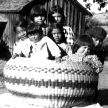
Stories, Songs, and Sights of Native Mendocino County
Developed by
The Mendocino County Library in cooperation with Apple Computer Inc. and The California State Library

The Product
Singing Light is a collection on CD-ROM of historical photographs and sound recordings of native peoples of Mendocino County, California including their buildings, artifacts, songs, and stories.
The Medium
Macintosh-compatible CD ROM for Macintosh computers. Software on the CD includes versatile search features to assist academic research as well as casual browsing.
The Story
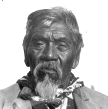
Mendocino County, like so many other regions in our country, has an old story to tell. It is about the first people of this land—the Pomo and other tribes—who lived in harmony with the earth for ten thousand years. Much of this story can never b e told. It is not written, and the people who could have passed it on orally were nearly destroyed. But, much also remains. It exists in artifacts, sound recordings and photographs made in the late nineteenth and twentieth centuries. And, of course, the s tory is in the personal archives and in the hearts and minds of Native Americans alive today.
Much of this culture remains, but the older artifacts and photographs have been undergoing a process of slow oblivion. Memories are fading and the physical evidence—the photographs and audio tapes—are deteriorating in people's closets and the ar chives of museums.
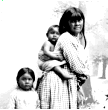 Both Apple Computer and The California State Library provided grants, equipment, and support to a team of Mendocino County Library volunteers and staff to explore new methods to deliver this information. We borrowed materials from various institutions, di gitized them, and developed a computer interface to allow access. Keeping in mind that we were working on materials from an oral culture we tried to design the interface with an emphasis on visual cues. In fact it is possible to access most of the materia l without reading.
Both Apple Computer and The California State Library provided grants, equipment, and support to a team of Mendocino County Library volunteers and staff to explore new methods to deliver this information. We borrowed materials from various institutions, di gitized them, and developed a computer interface to allow access. Keeping in mind that we were working on materials from an oral culture we tried to design the interface with an emphasis on visual cues. In fact it is possible to access most of the materia l without reading.
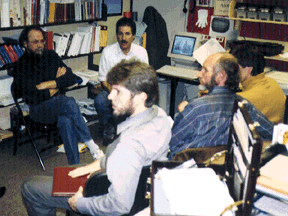 A meeting
A meeting
of the steering
committee.
Anti-
clockwise
from the
top: Pat,
Urmas Kaldveer,
Douglas Burns,
Dale Glaser,
Bob Laughton
This was a project of Native Americans, educators, computer enthusiasts, and others who volunteered time to create Singing Light. Some of us were attracted by the dreamy hardware set up, some by interest in information technology, and many were attracted by the humanitarian element of cultural exchange and education.
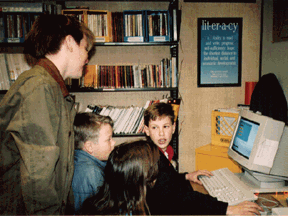
Some student volunteers.
Age eleven
and up,
they did
much of the
scanning as a
school project
What's Next
We have come to expect that digital technology will march on for at least another ten years at its current speedy rate. The social repercussions may continue to evolve for another ten or twenty years beyond that. All of this points to the likelihood of fu ture libraries being digital. This project shows how a small rural library, using mostly volunteer staff can begin to preserve its own local history with the help of this technology. We are experimenting with distribution of this material on high bandwidt h networks. CD-ROM is a good medium for archives and transport of this kind of data. Still the future of data distribution is 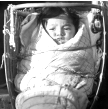 likely to be from fast memory through network servers. The great advantage of the network is that it allows instant editing of the data thus updating and expansion can be easily accomplished a nd immediately delivered to the users. The most exciting aspect of network distribution is the possibility of user feedback. This will allow comments and contributions by the users.
likely to be from fast memory through network servers. The great advantage of the network is that it allows instant editing of the data thus updating and expansion can be easily accomplished a nd immediately delivered to the users. The most exciting aspect of network distribution is the possibility of user feedback. This will allow comments and contributions by the users.
June 1991